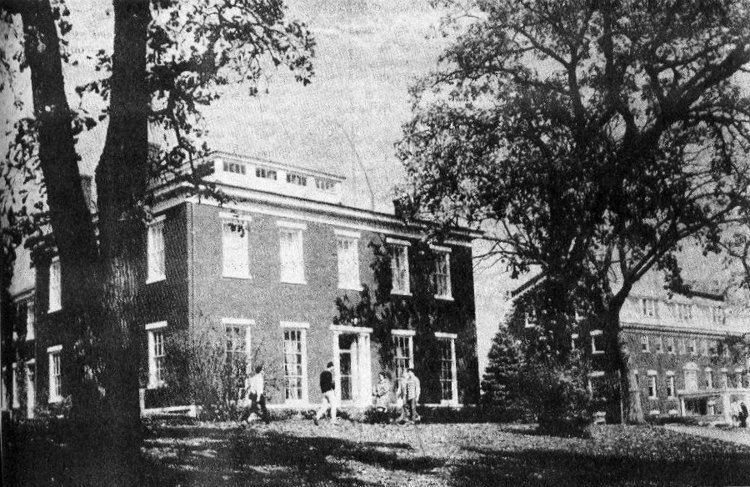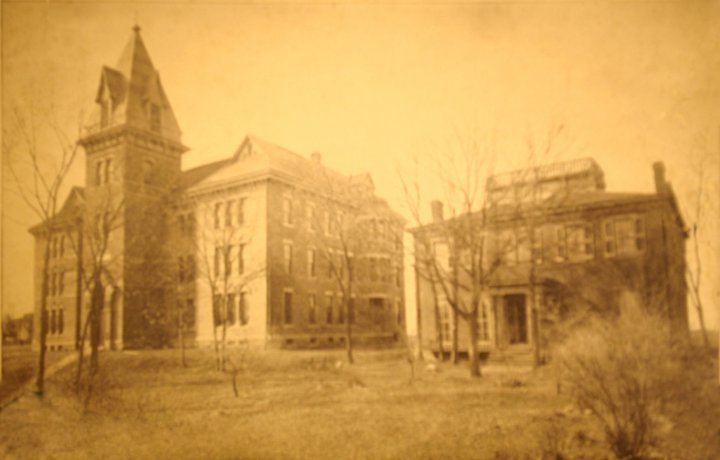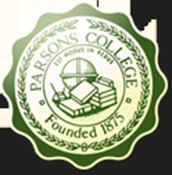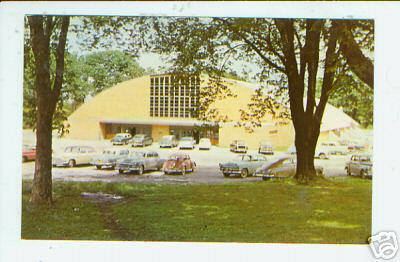Colors Green and White Campus size 110 ha Founded 1875 Color Green and White | Established 1875, closed in 1973 Nickname Wildcats Ceased operations 1973 Motto Est Modus In Rebus | |
 | ||
President Millard G. Roberts, 1955–67 Notable alumni Marcia Wallace, Richard L Lawson, William E Andrews, Rhine McLin, Carol M Highsmith Similar Midwestern College, Maharishi University of Manag, Hiram Scott College, Parsons School of Design, Westmar University | ||
Parsons college graduation
Parsons College was a private liberal arts college located in Fairfield, Iowa. The school was named for its wealthy benefactor, Lewis B. Parsons Sr., and was founded in 1875 with one building and 34 students. Over the years new buildings were constructed as enrollment expanded. The school lost its accreditation in 1948 but regained it two years later. In 1955 the school appointed Millard G. Roberts as its president and this began a period of rapid expansion with the student population rising as high as 5,000 by 1966. There was a turning point, however, in 1966 when Life magazine published an article criticizing the college and its president. Later that year the school lost its accreditation and Roberts was asked to resign as president. Enrollment quickly declined and the college floundered with $14 million in debt and closed under bankruptcy in 1973.
Contents
- Parsons college graduation
- Mum time travel to parsons college
- 1875 to 1954
- 1955 to 1973
- Notable alumni
- References

Mum time travel to parsons college
1875 to 1954

Parsons College was named for Lewis B. Parsons, Sr., a wealthy New York merchant who died in 1855 and left much of his estate as an endowment for an institution of higher learning in Iowa. His sons, the executors of Parsons' estate, considered a number of possible locations for the school and 20 years later chose a tract of land just north of Fairfield. The residents of Fairfield promised $27,516 towards the college, and its committee paid W.H. Jordan $13,000 for Henn Mansion building and 20 acres of land.

The college opened in 1875 with 34 students who attended classes in the brick home called "the Mansion" that was built in 1857 by Congressman Bernhart Henn. The faculty were three Presbyterian ministers and enrollment grew to 63 students by year end. Alexander G. Wilson was in charge of faculty and held the title of "rector." He also oversaw the college's preparatory department, which later became the Parsons Academy until its closure in 1917. A $7,000 chapel building was erected in 1876, and John Armstrong succeeded Wilson and assumed the title of college president, until August 12, 1879, when he died suddenly. The third president was Thomas Davis Ewing, who served from 1880 to 1890; the Mansion was later renamed Ewing Hall in his honor. A west wing was added to the chapel in 1882 by Des Moines architects Bell & Hackney, and an east wing was added in 1890-91 with a $15,000 donation from W. R. Ankeny of Des Moines, for whom the chapel was renamed Ankeny Hall.

The first football game played at Parsons was on September 16, 1893, against Elliot Business College of Burlington, Iowa. Parsons won by a score of 70-0. This monumental win prompted the construction of Blum stadium for the 1894 season. In 1896 Daniel E. Jenkins became college president at the age of 30 and was the youngest of the 16 who held the title during the school's 98-year history. Ankeny Hall contained the chapel, the library, and the classrooms when it was destroyed by fire in August 1902, leaving the college with only two buildings: Henn Mansion and a newly constructed women's dormitory called Ballard Hall.

The college rebounded by raising funds from board members and other local residents for new construction. In 1903 Fairfield Hall and Foster Hall were completed and the Carnegie Library was opened in 1907 due in part to a donation from philanthropist Andrew Carnegie. These new buildings were in the Beaux Arts-style and were designed by a Chicago architect named Henry K. Holsman. In 1908, college trustee, Theodore Wells Barhydt donated $33,000 for a chapel which was built in Norman Gothic style and designed by Holsman. It was completed in 1909 and named the Barhydt Memorial Chapel in honor of Barhydt's parents. The chapel included $1,800 worth of art-glass windows. The Trustee Gymnasium opened in 1910 and later an extension to the chapel called the Bible Building and later renamed Parsons Hall.

Enrollment steadily increased after World War I but declined during the World War II years, and in 1948 parsons lost its accreditation. The college was strengthened by appointment of college president Tom E. Shearer in 1948 and it regained accreditation in 1950.
1955 to 1973
In 1955, the trustees appointed a Presbyterian minister from New York City, Millard G. Roberts, as president of the 357-student college. Roberts spent $10,000 on his October inauguration and over the years was both hailed and criticized for his "flamboyant" management style. His first objective was to increase enrollment and for 10 years Parsons College had the highest percentage of enrollment increases nationwide. When the number of students reached the 1,000 mark, new dormitories were quickly built to keep up with the demand. In 1958 Roberts was voted "Man of the Year" by the local Chamber of Commerce and in 1960 was given a new Cadillac by 40 grateful businessmen.
Among Roberts's innovations at the college was the establishment of the trimester system which made year-round use of the facility and allowed students to reduce the time needed to obtain a degree. He lowered admission requirements and Parsons became known as a school that gave students a second chance. He increased the student-teacher ratio, streamlined the academic curriculum, and established recruiters around the country. In 1961 the football team played Northeast Missouri State Teachers College in the Mineral Water Bowl, losing 22-8.
In 1962 six professors filed a formal complaint against the college. The North Central Association (NCA) conducted an investigation and put the college on probation in 1963. In 1964 student enrollment reached 2,500, the probation was lifted in 1965, and enrollment reached 5,000 students in 1966. Roberts is reported to have "raided" other campuses for "strong faculty" by offering higher salaries and more benefits, and by 1966 the university had the third highest paid faculty in the nation. Despite huge increases in enrollment, however, the college's debt increased at an average rate of $100,000 per month during the approximately 144 months that Roberts was president.
In 1966 Life Magazine published an article criticizing Roberts and the university calling him "The Wizard of Flunk Out U". In 1966, a new football stadium, Blum Stadium was dedicated, and the football team played North Dakota in the 1966 Pecan Bowl in Abilene Texas. The 1966-67 basketball team coached by O.B. (Oscar Bernard) Nelson finished with a record of 18-7.
In 1967 the NCA revoked the college's accreditation citing "administrative weakness" and a $14 million debt. Roberts responded with threats of a lawsuit, and the college faculty voted 101 to 58 to remove Roberts from his position. In June 1967 the board of trustees asked for his resignation. William B. Munson became acting president for two months and was succeeded by Wayne E. Stamper, who served from 1967-1968. The school played its final season of football in 1970. Within a year's time enrollment "dropped sharply" to 2,000 students. The school's enrollment plunged from 5,000 to 1,500 and though accreditation was regained in the spring of that year, the upheaval of the late 1960s had fatally destabilized the underpinnings of the college, and enrollment continued to drop. The Parsons College softball team appeared in the Women's College World Series in 1971. In 1973, Everett E. Hadley became acting president of the college.
Several innovative programs were begun, such as a "Foreign Language - Foreign Service Institute" and the "Religious Service Community," both of which attracted new students. However, enrollment dropped to 925 students and the school went into federal bankruptcy and closed in 1973. Over the years Roberts had created satellite colleges that operated under the leadership of Parsons. They were Lea College in Albert Lea, Minn., John J. Pershing College in Beatrice, Neb.; Charles City College in Charles City, Iowa; College of Artesia in Artesia, N.M.; Hiram Scott College in Scottsbluff, Neb.; and Midwestern College in Denison, Iowa. However, by 1973, all had fallen into bankruptcy. In August 1974, the campus was purchased by Maharishi International University.
